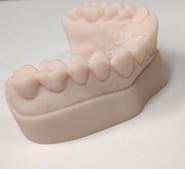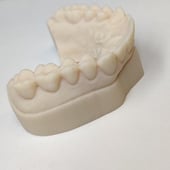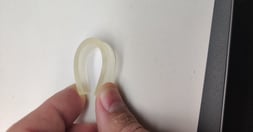Physical properties are the characteristics that determine how a 3D print resin appears and performs. There are numerous properties that can be considered, such as Color, Viscosity (when in a liquid state), Density, Water Absorption, Hardness, Toughness, Flexural Strength, Flexural Modulus of Elasticity, Tensile Strength, etc. The list can truly go on forever. Not all of these properties are always important and as such, they are not always evaluated. For example, Water Absorption is an important factor for medical devices such as Splints but has little to no consequence for printed model resins that are intended for strictly for models. The properties that have been determined to be essential for a 3D print resin’s intended use are evaluated based on a set of testing standards. For every physical property, there can be numerous standards that are used as the basis for evaluation. These standards detail how to test for specific properties, including information on what equipment is needed for testing and details on test conditions. ASTM International (formerly known as American Society for Testing and Materials) and ISO (International Organization for Standardization) are two of the most common standards organizations, however, there are many that are used around the world.
When looking at the reported value of a physical property, it is important to note which standard was used to obtain a result. Even when different test methods aim to evaluate the same property, the differences in test conditions such as sample sizes, sample conditioning, test speeds, etc. can cause a difference in results. Even the color of a resin, typically one of the first properties that is evaluated when choosing a 3D print resin, is evaluated differently depending on which standard is used. The various standards can differ on everything from the light source and the background used, to the intensity of the light source.
When performing a quick visual evaluation on a model made from Whip Mix’s VeriModel OS Ivory, it can appear different when looked at under different light sources while keeping all other factors consistent (Pictured below).



D65/10 Light Source Fluorescent Light Source 84-P Light Source
Changing only one variable on something as simple as a visual evaluation can cause noticeable differences so it is easy to imagine how changing multiple factors between the different standards can lead to different results when testing, even when the testing is done on the same sample.
Color is among the first properties evaluated when determining which 3D print resin should be used, after all, everyone wants their printed objects to look visually appealing, however, it is not the only or even the most important factor. Color is an aspect of a resin that gets a large amount of attention, but it tends to be a superficial property. This means that typically the color does not factor into the performance of the resin; that is determined by the other physical properties. When evaluating the performance of the 3D print resin it is important to look at what the resin is going to be used for. If the end goal of a print is to create a rigid structure, a 3D print resin known for being flexible is going to lead to disappointing results when used.
While the relationships between the different physical properties are quite complex and can be affected by factors such as temperature, there tends to be a correlation when it comes to physical properties. This means that, generally, as one physical property is altered other properties are affected by the change. For example, as you increase the Hardness of a 3D print resin, the Flexural Strength and Flexural Modulus of Elasticity can increase. This can lead to a strong, rigid 3D print resin that is suited for creating models, but it may also be brittle and easy to break. 3D print resins with a lower Flexural Modulus of Elasticity value tend to also have lower Flexural Strengths and can be softer. These 3D print resins can create final objects with great flexibility, but they may be lacking the strength of other resins.


An example of a 3D print resin with low strength but high flexibility
Finding the balance between all of the different physical properties can be quite difficult as the “Perfect” 3D print resin simply does not exist. A certain degree of non-ideal properties, such as a higher than desired viscosity, can be allowed as long as a 3D print resin can meet the relevant standards, provided that the non-ideal properties do not sacrifice the quality of the product.
Using a 3D print resin that does not meet particular standards for relevant physical properties can lead to negative outcomes. A 3D print resin that is designed to be soft for a print that is intended to be strong and hard can lead to more frequent and drastic failures as it may not meet relevant standards regarding its strength. Using a 3D printing resin that has poor wear resistance for crowns or denture teeth can lead to unsatisfied patients and the need for more frequent replacements or, in the worst case scenario, injury to the patient through material failure. Using a 3D print resin that does not meet standards for water absorption for surgical guides or splints can cause health issues with patients due to leakage and lead to potential lawsuits. All of these issues can be avoided by being sure to use 3D print resins that meet the essential physical properties for an intended use.
Identifying which physical properties of 3D print resins are important is essential when choosing which resin to use. When using 3D print resins that do not have physical properties suited to the intended use, there is a higher risk of failure and dissatisfaction. Using 3D print resins with appropriate physical properties for the intended use helps to ensure that prints will lead to optimal results. Having 3D print resins meet or exceed relevant standards should give an even greater degree of confidence in the quality of printed objects and the outcome of the resin. Always be sure to use the right resin for the job!







Leave a comment